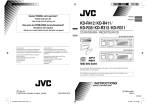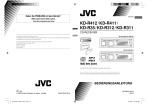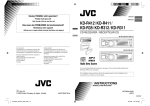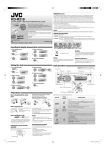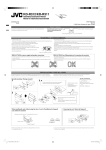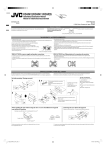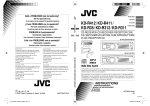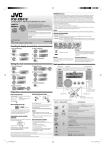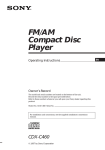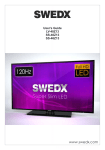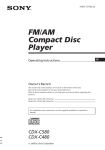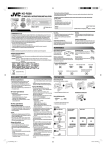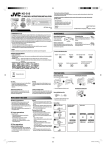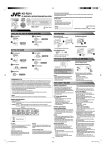Download JVC GET0632-001A User's Manual
Transcript
INFORMATION (For U.S.A.) This equipment has been tested and found to comply with the limits for a Class B digital device, pursuant to Part 15 of the FCC Rules. These limits are designed to provide reasonable protection against harmful interference in a residential installation. This equipment generates, uses, and can radiate radio frequency energy and, if not installed and used in accordance with the instructions, may cause harmful interference to radio communications. However, there is no guarantee that interference will not occur in a particular installation. If this equipment does cause harmful interference to radio or television reception, which can be determined by turning the equipment off and on, the user is encouraged to try to correct the interference by one or more of the following measures: – Reorient or relocate the receiving antenna. – Increase the separation between the equipment and receiver. – Connect the equipment into an outlet on a circuit different from that to which the receiver is connected. – Consult the dealer or an experienced radio/TV technician for help. KD-R418 CD RECEIVER : INSTRUCTIONS/INSTALLATION Thank you for purchasing a JVC product. Please read all instructions carefully before operation, to ensure your complete understanding and to obtain the best possible performance from the unit. Caution: For customer Use: Enter below the Model No. and Serial No. which are located on the top or bottom of the cabinet. Retain this information for future reference. Model No. Serial No. Changes or modifications not approved by JVC could void the user’s authority to operate the equipment. IMPORTANT FOR LASER PRODUCTS 1. CLASS 1 LASER PRODUCT 2. CAUTION: Do not open the top cover. There are no user serviceable parts inside the unit; leave all servicing to qualified service personnel. 3. CAUTION: (For U.S.A.) Visible and/or invisible class II laser radiation when open. Do not stare into beam. (For Canada) Visible and/or invisible class 1M laser radiation when open. Do not view directly with optical instruments. 4. REPRODUCTION OF LABEL: CAUTION LABEL, PLACED OUTSIDE THE UNIT. 1009DTSMDTJEIN EN © 2009 Victor Company of Japan, Limited GET0632-001A [J] Canceling the display demonstration 1 Turn on the power. 4 Select <DEMO OFF>. For safety... 2 • Do not raise the volume level too much, as this will block outside sounds, making driving dangerous. • Stop the car before performing any complicated operations. [European Union only] 5 [Hold] (Initial setting) 3 6 Finish the procedure. Setting the clock Temperature inside the car... If you need to operate the unit while driving, be sure to look around carefully or you may be involved in a traffic accident. If you have parked the car for a long time in hot or cold weather, wait until the temperature in the car becomes normal before operating the unit. Basic operations 1 Turn on the power. 2 Warning: 5 Adjust the hour. [Hold] Ejects the disc Control dial Loading slot Display window 6 Adjust the minute. (Initial setting) 3 Select <CLOCK>. Auxiliary input jack Detaches the panel 7 Finish the procedure. Returns to the previous menu 4 Select <CLOCK SET>. Remote sensor • DO NOT expose to bright sunlight. Preparations USB (Universal Serial Bus) input jack How to attach/detach the control panel If the effectiveness of the remote controller decreases, replace the battery. When you press or hold the following button(s)... Replacing the lithium coin battery Main unit CR2025 Remote controller Turns on. • When the power is on, pressing /I/ATT on the remote controller also attenuates the sound or pauses. Press /I/ATT again to cancel muting or resume playback. Turns off if pressed and held. Selects the available sources (if the power is turned on). • If the source is ready, playback also starts. How to reset your unit Reset the unit after installation is completed. • Your preset adjustments will also be erased. • You can forcibly eject the loaded disc even if the disc is locked. To lock/unlock the disc, see page 2. • Be careful not to drop the disc when it ejects. • If this does not work, reset your unit. Preparing the remote controller (RM-RK50) When you use the remote controller for the first time, pull out the insulation sheet. EN_KD-R418[J]f.indd 1 Adjusts the volume level. Caution: [Hold] Insulation sheet For USA-California Only: This product contains a CR Coin Cell Lithium Battery which contains Perchlorate Material—special handling may apply. See www.dtsc.ca.gov/hazardouswaste/perchlorate — How to forcibly eject a disc General operations • Danger of explosion if battery is incorrectly replaced. Replace only with the same or equivalent type. • Battery shall not be exposed to excessive heat such as sunshine, fire, or the like. — Warning (about battery handling) To prevent accidents and damage: • Do not install any battery other than CR2025 or its equivalent. • Store out of reach of children. • Do not recharge, short, or dismantle. • Do not dispose of in fire. • Do not carry around with other metallic materials. • Wrap the battery with tape and insulate when throwing away or saving it. Selects items. • Mutes the sound while listening to a source. If the source is “CD” or “USB,” playback pauses. Press the control dial again to cancel muting or resume playback. • Confirms selection. Selects the sound mode. • Enters tone level adjustment directly (see page 3) if pressed and held EQ BASS-TRE on the main unit. — Enters playback mode menu directly (see page 2). — Power off : Checks the current clock time. Power on : Changes the display information. 1 10/23/09 2:30:38 PM Listening to the radio ~ Ÿ ] “FM” or “AM” Listening to the disc ~ Ÿ ] Turn on the power. “ST” lights up when receiving an FM stereo broadcast with sufficient signal strength. Manual search “M” flashes, then press the button repeatedly. All tracks will be played repeatedly until you change the source or eject the disc. Selecting a preset station 1 Stopping playback and ejecting the disc Selecting the playback modes “NO DISC” appears. Press / SOURCE to listen to another playback source. [Hold] or When an FM stereo broadcast is hard to receive 1 [Hold] 2 Prohibiting disc ejection [Hold] You can assign titles to 30 station frequencies (FM and AM) using 8 characters (maximum) for each title. ] <TUNER> ] <MONO> ] <MONO ON> Reception improves, but stereo effect will be lost. To restore the stereo effect, repeat the same procedure to select <MONO OFF>. Automatic presetting (FM)— SSM (Strong-station Sequential Memory) 1 2 To preset another 6 stations, repeat the above procedure by selecting one of the other six SSM setting ranges. Manual presetting (FM/AM) You can preset up to 18 stations for FM and 6 stations for AM. Ex.: Storing FM station of 92.50 MHz into preset number “04.” 1 ] “92.50MHz” 2 [Hold] “PRESET MODE” flashes. ] Show the title entry screen. 3 Selects folder of the MP3/ WMA ] Selects a character. 4 Selects track ] Move to the next (or previous) character position. Repeat steps 3 and 4 until you finish entering the title. [Hold] 6 To erase the entire title, press and hold DISP after step 2, then press the control dial. Fast-forwards or reverses the track 2 B K T 2 / C L U 3 < D M V 4 > E N W 5 F O X 6 G P Y 7 Space H Q Z 8 I R 0 9 For MP3/WMA discs, select the desired folder, then the desired track by repeating step 2. • To return to the previous menu, press BACK. 5 U / D ∞ : Selects folder of the MP3/ WMA 2 R / F 3 : Selects track 2 R / F 3 : Fast-forwards or reverses the [Hold] track Station name * = Frequency = Clock = (back to the beginning) * If no title is assigned to a station, “NO NAME” appears for a few seconds. Listening to the USB device Using the remote controller This unit can play MP3/WMA tracks stored in a USB device. ~ Ÿ You can connect an external component to the AUX (auxiliary) input jack on the control panel. • Make sure <AUX ON> is selected for the <SRC SELECT> = <AUX IN> setting on page 3. USB memory All tracks will be played repeatedly until you change the source or detach the USB device. If a USB device has been attached... Pressing / SOURCE turns on the power and playback starts from where it has been stopped previously. • If a different USB device is currently attached, playback starts from the beginning. 3.5 mm (3/16”) stereo mini plug (not supplied) 1 USB input jack ] Turn on the power. Listening to the external components 2 Using the remote controller Changing the display information ] Selects preset number “04.” “P04” flashes and “MEMORY” appears. ] “AUX IN” Turn on the connected component and start playing the source. Disc title/Album name/performer (folder name)* = Track title (file name)* = Current track number with the elapsed playing time = Current track number with the clock time = (back to the beginning) * If the current disc is an audio CD, “NO NAME” appears. If an MP3/WMA file does not have Tag information or <TAG DISPLAY> is set to <TAG OFF> (see page 3), folder name and file name appear. Available characters A J S 1 — To cancel repeat play or random play, select “RPT OFF” or “RND OFF.” Changing the display information Selecting a track/folder 1 5 U / D ∞ : Changes the preset stations 2 R / F 3 : Searches for stations 3 REPEAT TRACK RPT : Repeats current track FOLDER RPT : Repeats current folder RANDOM FOLDER RND : Randomly plays all tracks of current folder, then tracks of next folders : Randomly plays all tracks ALL RND Discs produce very little noise compared with other sources. Lower the volume before playing a disc to avoid damaging the speakers by the sudden increase of the output level. [Hold] 5 ] <TUNER> ] <SSM> ] <SSM 01 – 06> / <SSM 07 – 12> / <SSM 13 – 18> “SSM” flashes and local stations with the strongest signals are searched and stored automatically. 3 Caution on volume setting: ] “FM” or “AM” [Hold] 2 ] “REPEAT” j “RANDOM” To cancel the prohibition, repeat the same procedure. 1 You can preset up to 18 stations for FM. While listening to a station... 1 2 Assigning title to a station 2 You can use only one of the following playback modes at a time. Stopping playback and detaching the USB device Portable audio player, etc. Straightly pull it out from the unit. “NO USB” appears. Press / SOURCE to listen to another playback source. You can operate the USB device in the same way you operate the files on a disc. Caution on volume setting: USB devices produce very little noise compared with other sources. Lower the volume before playing a USB to avoid damaging the speakers by sudden increase of the output level. Cautions: • Avoid using the USB device if it might hinder your safety driving. • Do not pull out and attach the USB device repeatedly while “READING” is shown on the display. • Do not start the car engine if a USB device is connected. • This unit may not be able to play the files depending on the type of USB device. • Operation and power supply may not work as intended for some USB devices. • You cannot connect a computer to the USB input terminal of the unit. • Make sure all important data has been backed up to avoid losing the data. • Do not leave a USB device in the car, expose to direct sunlight, or high temperature to avoid deformation or cause damages to the device. • Some USB devices may not work immediately after attaching USB device or turn on the power. • For more details about USB operations, see page 5. 2 EN_KD-R418[J]f.indd 2 10/23/09 2:30:40 PM Selecting a preset sound mode You can select a preset sound mode suitable for the music genre. FLAT = NATURAL = DYNAMIC = VOCAL BOOST = BASS BOOST = USER = (back to the beginning) Storing your own sound mode Tone You can store your own adjustments in memory. 1 While listening, you can adjust the tone level of the selected sound mode. BASS [Hold] MIDDLE 2 TREBLE 1 [Hold] ] <PRO EQ> ] <BASS> / <MIDDLE> / <TREBLE> Frequency 60 Hz, 80 Hz, 100 Hz, 200 Hz 0.5 kHz, 1.0 kHz, 1.5 kHz, 2.5 kHz 10.0 kHz, 12.5 kHz, 15.0 kHz, 17.5 kHz Sound element Level –06 to +06 –06 to +06 –06 to +06 Q Q1.0, Q1.25, Q1.5, Q2.0 Q0.75, Q1.0, Q1.25 Q FIX 3 2 Adjust the level (–06 to +06) of the selected tone (BASS / MIDDLE / TREBLE). The sound mode is automatically stored and changed to “USER.” 4 Adjust the sound elements of the selected tone ( see table on the right). Repeat steps 2 and 3 to adjust other tones. The adjustments made will be stored automatically in “USER.” The current sound mode changes to “USER” automatically. Menu operations Repeat step 2 if necessary. • To return to the previous menu, press BACK. • To exit from the menu, press DISP or MENU. DEMO • DEMO ON CLOCK SET • DEMO OFF [ 1:00 ] : Display demonstration will be activated automatically if no operation is done for about 20 seconds. : Cancels. : Adjust the hour, then the minute. BASS MIDDLE TREBLE DIMMER — : For settings, see “Storing your own sound mode.” DISPLAY SCROLL *1 TAG DISPLAY SSM *2 TUNER AREA MONO *2 IF BAND Category • WIDE Selectable setting, [Initial: Underlined] R06 – F06 [ 00 ] L06 – R06 [ 00 ] • LOUD ON • LOUD OFF VOL ADJUST VOL ADJ –05 — VOL ADJ +05 [VOL ADJ 00] • DIMMER ON : Dims the display and button illumination. • DIMMER OFF : Cancels. : Scrolls the displayed information once. • SCROLL ONCE : Repeats scrolling (at 5-second intervals). • SCROLL AUTO : Cancels. • SCROLL OFF Pressing DISP for more than one second can scroll the display regardless of the setting. • TAG ON : Shows the Tag information while playing MP3/WMA tracks. : Cancels. • TAG OFF : For settings, see “Automatic presetting (FM)—SSM • SSM 01 – 06 (Strong-station Sequential Memory)” on page 2. • SSM 07 – 12 • SSM 13 – 18 • AREA US : When using in North/Central/South America. AM/FM intervals are set to 10 kHz/200 kHz. : When using in any other areas. AM/FM intervals are set • AREA EU to 9 kHz/50 kHz (100 kHz during auto search). : When using in South American countries where FM • AREA SA interval is 100 kHz. AM interval is set to 10 kHz. • MONO ON : Activate monaural mode to improve FM reception, but stereo effect will be lost. : Restore the stereo effect. • MONO OFF • AUTO Menu item FADER *3 BALANCE *4 LOUD Selectable setting, [Initial: Underlined] CLOCK DEMO Menu item 3 PRO EQ Category 2 AUDIO [Hold] L/O MODE SUB.W LEVEL *5 BEEP AMP GAIN *6 *1 *2 *3 *4 *5 *6 : Increases the tuner selectivity to reduce interference noises between adjacent stations. (Stereo effect may be lost.) : Subject to interference noises from adjacent stations, but sound quality will not be degraded and the stereo effect will remain. *7 *8 • SUB.W • REAR SUB.W FREQ *5 SRC SELECT 1 AM *7 AUX IN *8 • LOW • MID • HIGH SUB.W 00 — SUB.W 08 [ SUB.W 04 ] • BEEP ON • BEEP OFF • LOW POWER • HIGH POWER • AM ON • AM OFF • AUX ON • AUX OFF : Adjust the front and rear speaker output balance. : Adjust the left and right speaker output balance. : Boost low and high frequencies to produce a wellbalanced sound at a low volume level. : Cancels. : Preset the volume adjustment level of each source (except FM), compared to the FM volume level. The volume level will automatically increase or decrease when you change the source. • Before making an adjustment, select the source you want to adjust. • “VOL ADJ FIX” appears on the display if “FM” is selected as the source. : Select if the REAR LINE OUT terminals are used for connecting a subwoofer (through an external amplifier). : Select if the REAR LINE OUT terminals are used for connecting the speakers (through an external amplifier). : Frequencies lower than 72 Hz are sent to the subwoofer. : Frequencies lower than 111 Hz are sent to the subwoofer. : Frequencies lower than 157 Hz are sent to the subwoofer. : Adjust the subwoofer output level. : Activates the keypress tone. : Deactivates the keypress tone. : VOLUME 00 – VOLUME 30 (Select if the maximum power of each speaker is less than 50 W to prevent damaging the speakers.) : VOLUME 00 – VOLUME 50 : Enable “AM” in source selection. : Disable “AM” in source selection. : Enable “AUX IN” in source selection. : Disable “AUX IN” in source selection. Some characters or symbols will not be shown correctly (or will be blanked) on the display. Displayed only when the source is “FM.” If you are using a two-speaker system, set the fader level to “00.” This adjustment will not affect the subwoofer output. Displayed only when <L/O MODE> is set to <SUB.W>. The volume level automatically changes to “VOLUME 30” if you change to <LOW POWER> with the volume level is set higher than “VOLUME 30.” Displayed only when any source other than “AM” is selected. Displayed only when any source other than “AUX IN” is selected. 3 EN_KD-R418[J]f.indd 3 10/23/09 2:30:40 PM Electrical connections Installation This unit is designed to operate on 12 V DC, NEGATIVE ground electrical systems. If your vehicle does not have this system, a voltage inverter is required, which can be purchased at JVC car audio dealers. IMPORTANT: A custom wiring harness (separately purchased) which is suitable for your car is recommended for connection between the unit and your car. • Consult your JVC car audio dealer or a company supplying kits for details. Prepare these before installation.... PRECAUTIONS on power supply and speaker connections Warnings • DO NOT connect the speaker leads of the power cord to the car battery; otherwise, the unit will be seriously damaged. • BEFORE connecting the speaker leads of the power cord to the speakers, check the speaker wiring in your car. • To prevent short circuits: – Disconnect the battery’s negative terminal and make all electrical connections before installing the unit. – Cover the terminals of the UNUSED leads with insulating tape. • Be sure to ground this unit to the car’s chassis again after installation. • Replace the fuse with one of the specified rating. • Connect speakers with a maximum power of more than 50 W (impedance of 4 Ω to 8 Ω). Otherwise, change the <AMP GAIN> setting. (See “Menu operations” on page 3.) • The heat sink becomes very hot after use. Be careful not to touch it when removing this unit. Connecting the external amplifier or subwoofer Heat sink Y-connector *1 To the blue (white stripe) lead of the unit Remote lead Parts List A Hard case .................................................................................1 B Control panel.........................................................................1 C Sleeve .........................................................................................1 Signal cord *1 D Trim plate .................................................................................1 E Power cord..............................................................................1 F Handles .....................................................................................2 JVC Amplifier Rear speakers or subwoofer Make the <L/O MODE> setting accordingly. (See “Menu operations” on page 3.) *2 The following illustration shows a typical installation. If you have any questions or require information regarding installation kits, consult your JVC car audio dealer or a company supplying kits. In-dash mounting 15 A fuse Rear ground terminal Reset the unit Antenna input When you stand the unit, be careful not to damage the fuse on the rear. Do the required electrical connections. Connect only the front speakers if your speaker system is twospeaker system. White Install the unit at an angle of less than 30˚. Front speaker (left) Bend the appropriate tabs to hold the sleeve firmly in place. Black To the metallic body or chassis of the car *1 *1 White (black stripe) Ignition switch Gray Front speaker (right) Yellow *3 Gray (black stripe) To a live terminal (constant 12 V) Fuse block When installing the unit without using the sleeve Flat head screws—M5 × 8 mm (3/8”) *1 Green Rear speaker (left) Green (black stripe) Red To an accessory terminal Pocket Bracket *1 Purple Removing the unit Rear speaker (right) Release the rear section first... Purple (black stripe) Blue (white stripe) To the remote lead of other equipment or automatic antenna if any (200 mA max.) *1 Not supplied for this unit. *2 Firmly attach the ground wire to the metallic body or to the chassis of the car—to the place uncoated with paint. *3 Before checking the operation of this unit prior to installation, this lead must be connected, otherwise the power cannot be turned on. 4 EN_KD-R418[J]f.indd 4 10/23/09 2:30:41 PM More about this unit Troubleshooting Symptom General Sound cannot be heard from the speakers. “PROTECT” appears on the display and no operations can be done. This unit does not work at all. “AUX IN” cannot be selected. Disc playback FM/AM SSM automatic presetting does not work. Static noise while listening to the radio. Connect the antenna firmly. “AM” cannot be selected. Check the <SRC SELECT> = <AM> setting. (See “Menu operations” on page 3.) Disc cannot be played back. • CD-R/CD-RW cannot be played back. • Tracks on the CD-R/CD-RW cannot be skipped. Disc can be neither played back nor ejected. Disc sound is sometimes interrupted. Insert the disc correctly. • Insert a finalized CD-R/CD-RW. • Finalize the CD-R/CD-RW with the component which you used for recording. • Unlock the disc. (See page 2.) • Eject the disc forcibly. (See page 1.) • Stop playback while driving on rough roads. • Change the disc. • Check the cords and connections. Insert a playable disc into the loading slot. Press 0, then insert a disc correctly. “NO DISC” appears on the display. “PLEASE” and “EJECT” appear alternately on the display. Disc cannot be played back. Installation/connection USB device playback MP3/WMA playback Noise is generated. General Remedy/Cause • If you turn off the power while listening to a track, playback will start from where it had been stopped previously next time you turn on the power. • If no operation is done for about 60 seconds after pressing MENU button, the operation will be canceled. • Adjust the volume to the optimum level. • Make sure the unit is not muted/paused. (See page 1.) • Check the cords and connections. Check to be sure the terminals of the speaker leads are covered with insulating tape properly, then reset the unit. (See page 1.) If “PROTECT” does not disappear, consult your JVC car audio dealer or a company supplying kits. Reset the unit. (See page 1.) Check the <SRC SELECT> = <AUX IN> setting. (See “Menu operations” on page 3.) Store stations manually. Tuner operations • During SSM search... – All previously stored stations are erased and the stations are stored anew. – When SSM is over, the station stored in the lowest preset number will be automatically tuned in. • When storing a station manually, the previously preset station is erased when a new station is stored in the same preset number. • If you try to assign titles to more than 30 station frequencies, “NAME FULL” appears. Delete unwanted titles before assignment. Disc/USB operations Caution for DualDisc playback • The Non-DVD side of a “DualDisc” does not comply with the “Compact Disc Digital Audio” standard. Therefore, the use of Non-DVD side of a DualDisc on this product may not be recommended. General • This unit has been designed to reproduce CDs/ CD Texts, and CD-Rs (Recordable)/CD-RWs (Rewritable) in audio CD (CD-DA), MP3 and WMA formats. • If you change the source while listening to a disc, playback stops. Next time you select “CD” as the playback source, playback will start from where it had been stopped previously. • If the ejected disc is not removed within 15 seconds, it is automatically inserted into the loading slot again to protect it from dust. Playback starts automatically. • Use a disc with MP3/WMA tracks recorded in a format compliant with ISO 9660 Level 1, Level 2, Romeo, or Joliet. • Add the extension code <.mp3> or <.wma> to the file names. Skip to another track or change the disc. (Do not add the extension code <.mp3> or <.wma> to non-MP3 or WMA tracks.) Do not use too many hierarchical levels and folders. A longer readout time is required (“READING” keeps flashing on the display). Tracks are not played back in the order Playback order is determined when the files are you have intended. recorded. “NO FILE” appears on the display. Selected folder is an empty folder *. Select another folder that contains MP3/WMA tracks. * Folder that is physically empty or folder that contains data but does not contain valid MP3/WMA track. “NOT SUPPORT” appears on the display Skip to the next track encoded in an appropriate format and track skips. or to the next non-copy-protected WMA track. The elapsed playing time is not correct. This sometimes occurs during playback. This is caused by how the tracks are recorded on the disc. The correct characters are not displayed This unit can only display letters (upper case), numbers, (e.g. album name). and a limited number of symbols. (See page 2.) Noise is generated. The track played back is not an MP3/WMA track. Skip to another file. (Do not add the extension code <.mp3> or <.wma> to non-MP3 or WMA tracks.) “READING” keeps flashing on the display. • Readout time varies depending on the USB device. • Do not use too many hierarchy or folders. • Turn off the power then on again. • Reattach the USB device again. “NO FILE” appears on the display. Selected folder is an empty folder*. Select another folder that contains MP3/WMA tracks. * Folder that is physically empty or folder that contains data but does not contain valid MP3/WMA track. “NOT SUPPORT” appears on the display Skip to the next track encoded in an appropriate format and track skips. or to the next non-copy-protected WMA track. Tracks/folders are not played back in the The playback order is determined by the write-in time order you have intended. stamp. The first track/folder written into the USB device will be the first track/folder for playback. • Attach a USB device that contains tracks encoded in • “CANNOT PLAY” flashes on the display. an appropriate format. • “NO USB” appears on the display. • Reattach the USB device again. • The unit cannot detect the USB device. While playing a track, sound is sometimes The MP3/WMA tracks have not been properly copied interrupted. into the USB device. Copy MP3/WMA tracks again into the USB device, and try again. Correct characters are not displayed (e.g. This unit can only display letters (upper case), numbers, album name). and a limited number of symbols. (See page 2.) The fuse blows. Connect the red and black leads correctly. Power cannot be turned on. Check to make sure the yellow lead is connected. No sound from the speakers. Check to make sure the speaker output lead is not shortcircuited. Sound is distorted. • Check to make sure the speaker output lead is grounded. • Check to make sure the “–” terminals of L and R speakers are grounded in common. Noise interfere with sounds. Check to make sure the rear ground terminal connected to the car’s chassis is using shorter and thicker cords. This unit becomes hot. • Check to make sure the speaker output lead is grounded. • Check to make sure the “–” terminals of L and R speakers are grounded in common. This unit does not work at all. Reset the unit. (See page 1.) Playing a CD-R or CD-RW • Use only “finalized” CD-Rs or CD-RWs. • This unit can play back multi-session discs; however, unclosed sessions will be skipped while playing. • Some CD-Rs or CD-RWs may not be played back on this unit: – Discs are dirty or scratched. – Moisture condensation has occurred on the lens inside the unit. – The pickup lens inside the unit is dirty. – The files on the CD-R/CD-RW are written using the “Packet Write” method. – There are improper recording conditions (missing data, etc.) or media conditions (stained, scratched, warped, etc.). • CD-RWs may require a longer readout time since the reflectance of CD-RWs is lower than that of regular CDs. Playing an MP3/WMA disc • This unit can play back MP3/WMA files with the extension code <.mp3> or <.wma> (regardless of the letter case—upper/lower). • This unit can show the names of albums, artists (performer), and tag (Version 1.0, 1.1, 2.2, 2.3, or 2.4) for MP3 files and for WMA files. • This unit can display only one-byte characters. No other characters can be correctly displayed. • This unit can play back MP3/WMA files meeting the conditions below: – Bit rate: 32 kbps — 320 kbps – Sampling frequency of MP3: 32 kHz, 44.1 kHz, 48 kHz (for MPEG-1) 16 kHz, 22.05 kHz, 24 kHz (for MPEG-2) – Sampling frequency of WMA: 22.05 kHz, 32 kHz, 44.1 kHz, 48 kHz – Disc format: ISO 9660 Level 1/ Level 2, Romeo, Joliet, Windows extension • The maximum number of characters for file/folder names vary depending on the disc format used (includes 4 extension characters—<.mp3> or <.wma>). – ISO 9660 Level 1: up to 12 characters; ISO 9660 Level 2: up to 31 characters; Romeo: up to 64 characters; Joliet: up to 32 characters; Windows extension: up to 64 characters • This unit can recognize a total of 512 files, 255 folders, and 8 hierarchical levels. • This unit can play back files recorded in VBR (variable bit rate). Files recorded in VBR have a discrepancy in the elapsed time display, and do not show the actual elapsed time. In particular, this difference becomes noticeable after performing the search function. • This unit cannot play back the following files: – MP3 files: encoded in MP3i and MP3 PRO format; an inappropriate format; layer 1/2. – WMA files: encoded in lossless, professional, and voice format; not based upon Windows Media® Audio; copy-protected with DRM. – Files which have data such as AIFF, ATRAC3, etc. • The search function works but search speed is not constant. Playing MP3/WMA tracks from a USB device • While playing from a USB device, the playback order may differ from other players. • This unit may be unable to play back some USB devices or some files due to their characteristics or recording conditions. • Depending on the shape of the USB devices and connection ports, some USB devices may not be attached properly or the connection might be loose. • Connect one USB mass storage class device to the unit at a time. Do not use a USB hub. • If the connected USB device does not have the correct files, “CANNOT PLAY” appears. • This unit can show Tag (Version 1.0, 1.1, 2.2, 2.3, or 2.4) for MP3 files and for WMA files. • This unit can play back MP3/WMA files meeting the conditions below: – Bit rate: 32 kbps — 320 kbps – Sampling frequency of MP3: 32 kHz, 44.1 kHz, 48 kHz (for MPEG-1) 16 kHz, 22.05 kHz, 24 kHz (for MPEG-2) – Sampling frequency of WMA: 22.05 kHz, 32 kHz, 44.1 kHz, 48 kHz • This unit can play back MP3 files recorded in VBR (variable bit rate). • The maximum number of characters for: – Folder names: 32 characters; File names: 32 characters; MP3 Tag: 64 characters; WMA Tag: 32 characters • This unit can recognize a total of 5 000 files, 255 folders (255 files per folder including folder without unsupported files), and of 8 hierarchies. • This unit does not support SD card reader. • This unit cannot recognize a USB device whose rating is other than 5 V and exceeds 500 mA. • USB devices equipped with special functions such as data security functions cannot be used with the unit. • Do not use a USB device with 2 or more partitions. • This unit may not recognized a USB device connected through a USB card reader. • This unit may not play back files in a USB device properly when using a USB extension cord. • This unit cannot play back the following files: – MP3 files: encoded in MP3i and MP3 PRO format; an inappropriate format; layer 1/2. – WMA files: encoded in lossless, professional, and voice format; not based upon Windows Media® Audio. Microsoft and Windows Media are either registered trademarks or trademarks of Microsoft Corporation in the United States and/or other countries. JVC bears no responsibility for any loss of the data in the USB mass storage class device while using this System. 5 EN_KD-R418[J]f.indd 5 10/27/09 8:59:59 AM Specifications Maintenance How to clean the connectors To play new discs Wipe the connectors with a cotton swab or cloth moistened with alcohol. Remove any rough areas from the inner and outer edges of the disc. Connectors Moisture condensation Moisture may condense on the lens inside the unit. Eject the disc and leave the unit turned on for a few hours until the moisture has evaporated. To keep discs clean Wipe in a straight line from center of disc to edge. Do not use liquid cleaners, thinners, or benzene. AUDIO AMPLIFIER SECTION Power Output: 20 W RMS × 4 Channels at 4 Ω and ≤ 1% THD+N Signal-to-Noise Ratio: 80 dBA (reference: 1 W into 4 Ω) Do not use the following discs: Load Impedance: 4 Ω (4 Ω to 8 Ω allowance) Tone Control Range: Bass: ±12 dB (60 Hz, 80 Hz, 100 Hz, 200 Hz) Q1.0, Q1.25, Q1.5, Q2.0 Middle: ±12 dB (0.5 kHz, 1.0 kHz, 1.5 kHz, 2.5 kHz) Q0.75, Q1.0, Q1.25 Treble: ±12 dB (10.0 kHz, 12.5 kHz, 15.0 kHz, 17.5 kHz) Q (Fixed) Frequency Response: 40 Hz to 20 000 Hz Line-Out Level/Impedance: 2.5 V/20 kΩ load (full scale) Subwoofer-Out Level/Impedance: 2.5 V/20 kΩ load (full scale) Output Impedance: 1 kΩ Other Terminal: USB input jack, AUX (auxiliary) input jack, Antenna input • Single CD—8 cm (3-3/16”) disc • Warped disc • Disc with sticker and sticker residue • Disc with stick-on label • Unusual shape disc • C-thru Disc (semi-transparent disc) • Disc with transparent or semi-transparent parts on its recording area TUNER SECTION Frequency Range: FM: 87.5 MHz to 107.9 MHz (with channel interval set to 100 kHz or 200 kHz) 87.5 MHz to 108.0 MHz (with channel interval set to 50 kHz) AM: 530 kHz to 1 710 kHz (with channel interval set to 10 kHz) 531 kHz to 1 602 kHz (with channel interval set to 9 kHz) Having TROUBLE with operation? Please reset your unit Still having trouble?? Call 1-800-252-5722 (USA ONLY) http://www.jvc.com [FM Tuner] Usable Sensitivity: 9.3 dBf (0.8 μV/75 Ω) 50 dB Quieting Sensitivity: 16.3 dBf (1.8 μV/75 Ω) Alternate Channel Selectivity (400 kHz): 65 dB Frequency Response: 40 Hz to 15 000 Hz Stereo Separation: 40 dB [AM Tuner] Sensitivity/Selectivity: 20 μV/40 dB CD PLAYER SECTION Type: Compact disc player Signal Detection System: Non-contact optical pickup (semiconductor laser) Number of channels: 2 channels (stereo) Frequency Response: 5 Hz to 20 000 Hz Dynamic Range: 96 dB Signal-to-Noise Ratio: 98 dB Wow and Flutter: Less than measurable limit MP3 Decoding Format: MPEG1/2 Audio Layer 3 Max. Bit Rate: 320 kbps WMA (Windows Media® Audio) Decoding Format: Max. Bit Rate: 320 kbps USB SECTION USB Standard: USB 1.1, USB 2.0 Data Transfer Rate (Full Speed): Max. 12 Mbps Compatible Device: Mass storage class Compatible File System: FAT 32/16/12 Playable Audio Format: MP3/WMA Max. Current: DC 5 V 500 mA GENERAL Power Requirement: Operating Voltage: DC 14.4 V (11 V to 16 V allowance) Grounding System: Negative ground Allowable Operating Temperature: 0°C to +40°C (32°F to 104°F) Dimensions (W × H × D): Installation Size (approx.): 182 mm × 52 mm × 160 mm (7-3/16” × 2-1/16” × 6-5/16”) Panel Size (approx.): 188 mm × 58 mm × 6 mm (7-7/16” × 2-5/16” × 1/4”) Mass (approx.): 1.3 kg (2.9 lbs) (excluding accessories) Design and specifications are subject to change without notice. If a kit is necessary for your car, consult your telephone directory for the nearest car audio speciality shop. 6 EN_KD-R418[J]f.indd 6 10/23/09 2:30:41 PM






